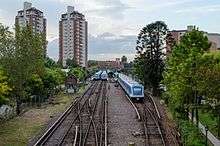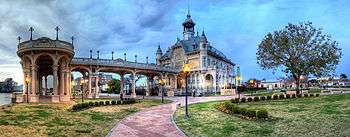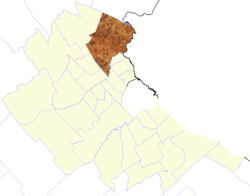Tigre, Buenos Aires
| Tigre | |||
|---|---|---|---|
|
| |||
| |||
 Tigre Location in Greater Buenos Aires | |||
| Coordinates: 34°25′S 58°35′W / 34.417°S 58.583°WCoordinates: 34°25′S 58°35′W / 34.417°S 58.583°W | |||
| Country |
| ||
| Province |
| ||
| Partido | Tigre | ||
| Elevation | 2 m (7 ft) | ||
| Population (2010 census [INDEC]) | |||
| • Total | 380,709 hab. | ||
| CPA Base | B 1648 | ||
| Area code(s) | +54 11 | ||
Tigre (Spanish pronunciation: [ˈtiɣɾe], Tiger) is a town in the Buenos Aires Province, Argentina, situated in the north of Greater Buenos Aires, 28 km (17 mi) north of Buenos Aires city. Tigre lies on the Paraná Delta and is an important tourist and weekend attraction, easily reached by bus and train services, including the scenic Tren de la Costa. It is the principal town of the Tigre Partido.
The town sits on an island created by several small streams and rivers and was founded in 1820, after floods had destroyed other settlements in the area, then known as the Partido de las Conchas.
The area's name derives from the “tigres” or jaguars that were hunted there, on occasions, in its early years. The area was first settled by Europeans who came to farm the land, and the port developed to serve the Delta and to bring fruit and wood from the Delta and ports upstream on the Paraná river. Tigre is still an important timber processing port. The “Puerto de Frutos” (fruit port) is now a crafts fair located in the old fruit market by the riverside. The Naval Museum is also nearby. Antiques shops, riverside restaurants and pubs, the casino and Parque de la Costa, an amusement park and its renowned natural beauty make Tigre a popular tourist destination throughout the year.
Tigre is also the starting point for a visit to the Paraná Delta. For locals and tourists alike, vintage mahogany commuter launches and motorboats are the favourite way to travel through its web of inter-connecting rivers and streams. English-style rowing clubs, countless marinas, humble dwellings and elegant mansions from the “Belle Époque”, such as the Tigre Club,[1] are to be seen, as well as small pensions and upscale lodges, restaurants, teahouses and simple picnic sites.
Tigre has, in recent years, seen an influx of people relocating to the city from other parts of Greater Buenos Aires. In recent years it has seen a rise in upmarket tourism, spawning new spa developments and clientele such as the pop star, Madonna.[2]
Transportation
Rail

The town of Tigre is served by two railway lines, the Mitre Line and the scenic Tren de la Costa, both terminate at walking distance from all venues.
- Mitre Line
- Retiro – Tigre (direct service Mitre Line)
The Mitre Line departs from Buenos Aires Retiro Station to Tigre Station every 10 – 30 minutes.
- Mitre Line / Tren de La Costa
- Retiro – Delta (Retiro to Bartolomé Mitre station with connection to Maipú station of Tren de la Costa)
Another alternative is to take the Retiro Station Mitre Line, usually from platforms 3 or 4 to the Bartolomé Mitre station (last station of this branch) where you can make a connection with the Tren de la Costa. Once you arrive at the station you must cross the pedestrian bridge over Avenida Maipú, which leads to the Maipú station of Tren de la Costa, where you can take the train to Delta station in the town of Tigre.
The Tren de la Costa has two types of tickets, a direct Maipú – Delta service and another that allows the visitor off at various stations without paying any extra (you can descend into the station you want in the same direction, each station offers various forms of entertainment and enjoyment). The Tren de la Costa runs every twenty minutes daily.
Maritime
Commuter passenger boats, water taxis and ferries provide public transport within the Tigre Delta.
Gallery
Canals in Tigre  Delta del Tigre
Delta del Tigre
Fruit market in 1902 
Tigre train station 
Delta train station 
Canals in Tigre Argentine Rowing Club 
B. Aires Rowing Club Tigre boat dock 
La Marina Rowing Club Port of Tigre 
Railway station, c. 1900 
Boat station Art Museum
See also
References
- ↑ In Argentina, Touring the Tigre Delta New York Times. 24 November 2010
- ↑ Family affair: Madonna treats her children to a Buenos Aires boat ride Daily Mail. 10 December 2010
External links
| Wikimedia Commons has media related to Tigre. |
- Official Municipality web site (Spanish/English)
- Victorica Promenade (Spanish)
- A Jaguar's Warning? The Rediscovered Tigre Delta (English)


